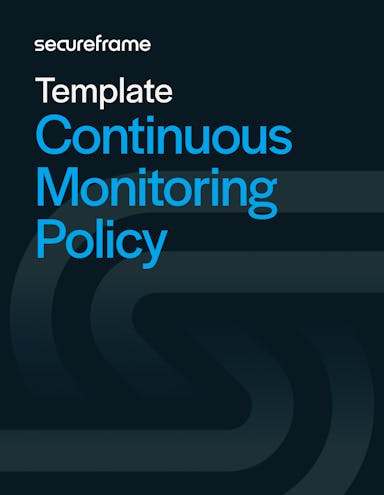
Cybersecurity Monitoring: Explaining the What, Why & How
Anna Fitzgerald
Senior Content Marketing Manager
Rob Gutierrez
Senior Cybersecurity and Compliance Manager, CISA, CCSK, CMMC RP
The latest FBI Internet Crime Report reveals that complaints of internet-related crimes increased slightly in 2024, while reported financial losses skyrocketed to an unprecedented $16.6 billion, a 33% year-over-year increase. This indicates that while cyber attacks are still increasing, the bigger concern is that they are becoming more effective and expensive.
That’s why cybersecurity monitoring is a foundational component of any security and compliance program. Cybersecurity monitoring provides the visibility and real-time insights needed to detect and respond to threats proactively to maintain a strong security and compliance posture.
This guide explores what cybersecurity monitoring is, why it matters, and how to implement it effectively using automation.
What is cybersecurity monitoring?
Cybersecurity monitoring is the continuous process of collecting, analyzing, and acting on security-related information from across an organization’s IT environment to maintain ongoing awareness of information security, vulnerabilities, and threats.
This process involves tracking user activity, system behavior, network traffic, and access patterns to identify anomalies or indicators of compromise. The goal is to detect and respond to threats in real time, or as early as possible, before attackers can cause harm.
When done effectively, cybersecurity monitoring helps organizations protect sensitive data, maintain business continuity, and meet requirements for regulations and industry standards such as SOC 2, ISO 27001, HIPAA, NIST 800-53, CMMC, and FedRAMP.
Let’s take a closer look at the importance of cybersecurity monitoring below.
Why cybersecurity monitoring is important
Cybersecurity monitoring is a core capability for organizations that want to move from a reactive to a proactive security model and have peace of mind about the confidentiality, integrity, and availability of their information systems and information.
Some of the key benefits of cybersecurity monitoring include:
- Awareness of threats and vulnerabilities: With continuous monitoring processes in place, your organization can more effectively identify unusual behavior, misconfigurations, and potential intrusions before they escalate.
- Timely response to risk: Monitoring provides timely, relevant, and accurate information that’s needed to investigate alerts, identify root causes, and remediate issues quickly.
- Met compliance requirements: Security frameworks like SOC 2, HIPAA, and CMMC mandate continuous monitoring in order to ensure the continued effectiveness of an organization’s security controls.
- Better risk visibility: A well-established continuous monitoring program provides a clear understanding of organizational risk tolerance. Understanding your real-time risk exposure enables everyone from senior leaders to the individuals operating information systems to set priorities and manage risk consistently throughout the enterprise.
- Enhanced operational resilience: Continuous monitoring can enable you to maintain visibility into the security of all assets and catch threats early, ultimately helping to prevent outages, breaches, and business disruption.
Recommended reading

Biggest Data Breaches of 2024: What Went Wrong and Key Lessons for Strengthening Cybersecurity
Key components of cybersecurity monitoring
A cybersecurity monitoring program consists of all the technologies, processes, and personnel working together to ensure threats and vulnerabilities are detected and addressed promptly. Let’s take a look at each major component below.
Cybersecurity monitoring tools
What security-related information is gathered and analyzed is foundational to the success of a continuous monitoring program. The best programs will leverage an automation tool like Secureframe that can integrate with a large and diverse pool of technologies that collect and analyze security data. This includes:
- Security information and event management (SIEM): SIEM systems collect and analyze logs from across your IT infrastructure—including servers, firewalls, endpoints, applications, and cloud environments. They use correlation rules and analytics to detect suspicious patterns, trigger alerts, and provide context for incident investigations.
- Intrusion detection and prevention systems (IDPS): These systems monitor network traffic to detect and, in the case of prevention systems, block malicious behavior.
- Endpoint detection and response (EDR): EDR solutions provide deep visibility into endpoint activities and enable rapid detection, investigation, and response to threats targeting desktops, laptops, and servers.
- Network traffic analysis (NTA): NTA tools examine data flow across networks to identify anomalies, unauthorized access, or data exfiltration attempts. They’re especially useful for detecting lateral movement and advanced persistent threats.
- Cloud security posture management (CSPM): CSPM solutions scan cloud infrastructure in real-time, providing ongoing visibility into the security posture of cloud assets across AWS, Azure,Google Cloud, and other environments.
- User and entity behavior analytics (UEBA): UEBA tools use machine learning to establish baselines for normal user and system behavior, then alert security teams to deviations that may indicate insider threats or compromised accounts.
- Vulnerability scanners: These tools identify known vulnerabilities and misconfigurations in systems, applications, and infrastructure.
Cybersecurity monitoring processes
Technology is critical, but it must be supported by processes that define how security monitoring is conducted, escalated, and improved.
Manual processes
While automation is increasingly prevalent, some activities still require human oversight:
- Log reviews and audits: Security analysts may manually review system logs and alerts to validate findings and uncover trends that automated tools might miss.
- Incident triage: Human judgment is often needed to determine the severity and context of an alert before launching a full response.
- Investigation and root cause analysis: In-depth investigations into incidents often require a hands-on approach to piece together timelines, artifacts, and threat actor behavior.
- Strategic decision-making: Crafting detection rules, baselining activity, and adjusting thresholds are all examples of strategic decision-making that typically require manual analysis and refinement by security professionals.
Automated processes
Automation enhances speed, consistency, and scalability, especially in large or complex environments. Here are some processes where automation can be particularly beneficial:
- Real-time alerting: Automated systems can trigger alerts based on predefined rules or behavior anomalies, like when a control changes from healthy to failing.
- Remediation workflows: Some tools, like Comply AI for Remediation, can automatically generate or execute remediation actions for misconfigurations or failed controls.
- Reporting: Automation tools can significantly simplify reporting with dashboards that consolidate all your most vital security and compliance metrics into a single screen, including the overall system health and control status, number of risks at different levels, and total vulnerabilities. Below is an example of Secureframe’s monitoring dashboard.

Cybersecurity monitoring personnel
A robust cybersecurity monitoring strategy requires coordination between multiple stakeholders and departments. Key roles include:
- Chief Risk or Information Security Officer: Security leaders, such as CROs or CISOs, are responsible for setting strategy, allocating resources, and communicating risks to the board or other decision-makers.
- Security analysts: These team members monitor alerts, perform investigations, and escalate or respond to incidents. They are the front line of defense in a SOC (Security Operations Center).
- Compliance officers or GRC teams: Depending on the size of your organization, there may be individuals dedicated to ensuring that monitoring activities align with regulatory requirements, industry standards, and internal policies and documenting evidence for audits.
- System administrators: These roles support the deployment and maintenance of information systems and are responsible for conducting or participating in the confirmation management, change management, and remediation processes and status reporting for their individual system.
- IT and engineering teams: Cybersecurity monitoring often requires input and support from broader IT and engineer teams to implement changes, patches, or architectural updates based on monitoring findings.
Recommended reading

5 Hardest Things About Security Compliance and How Technology Can Help
How to implement cybersecurity monitoring
Building a successful cybersecurity monitoring program requires more than just tools—it’s about strategy, prioritization, and integration. Here's how to approach implementation according to NIST 800-137.
1. Collect all security-related information
To start your security assessment, you need to collect all security-related information. This is often scattered across systems, servers, endpoints, cloud platforms, firewalls, and applications so manually collecting it can be tedious and time-consuming. Using an automation platform that integrates with your tech stack can help centralize this information, making it easier to analyze and report on.
2. Analyze the information
Once you have your assessment and monitoring results, it’s time to analyze these results to determine your risk responses (ie. whether you want to mitigate, transfer, avoid, or accept the risks).
Looking at recurring reports, automated reports, ad hoc reports, data feeds, databases, and whatever other data sources you have, you should analyze the information and determine your next steps based on a variety of factors, including:
- your stated risk tolerances
- the potential impact that vulnerabilities may have on information systems, mission/business processes, and organization as a whole
- the potential impact of mitigation options
3. Report findings
Now you’re ready to report on the results of the assessment, including whether your security controls are effective and adhere to organizational requirements. This can be done manually using templates or spreadsheets or automatically using dashboards and other reports.
4. Respond to findings and document
At this stage, you’re ready to implement your response strategies determined in step 2. This may involve modifying, enhancing, or adding security controls.
It’s essential to document all response strategies in the system’s Plan of Action and Milestones (POA&Ms). POA&Ms are essentially a list of issues or findings that must be remediated. This documentation supports compliance audits mainly for CMMC, FedRAMP, and other federal frameworks, and provides a clear roadmap for improving your security and compliance posture over time.
5. Review and update your monitoring strategy
Regularly conducting simulations, red team exercises, and tabletop incident response drills can help validate that your monitoring strategy is detecting threats and vulnerabilities effectively. You can use these testing results to identify areas for improvement and refine your strategy.
For example, you may need to change your security metrics or monitoring and assessment frequencies over time based on changes to your mission, organizational risk tolerance, or threat and vulnerability information.
6. Create a continuous monitoring policy
You should develop a policy to enforce your continuous monitoring strategy and ensure employees understand their roles and responsibilities. In addition to roles and responsibilities, this document should define:
- security metrics
- data sources
- the frequency of continuous monitoring activities
- procedures for control assessments, POA&Ms, and penetration testing
Like the strategy itself, your continuous monitoring policy should be regularly maintained, reviewed, updated, and distributed to relevant personnel.

Continuous Monitoring Policy Template
This policy can help ensure monitoring processes are performed consistently and at the correct frequencies and employees understand their roles and responsibilities. Download this customizable policy template to further build out your policy library.
Common challenges in cybersecurity monitoring and how to overcome them
Cybersecurity monitoring can be complex and resource-intensive. Here are some common challenges that organizations face when using manual processes:
- Alert fatigue: Overwhelmed security teams may overlook critical alerts because their alerting system is too noisy or not clear with critical information.
- Tool sprawl: Too many disconnected tools can lead to gaps in visibility.
- Skilled labor shortages: Many organizations lack trained security professionals.
- Compliance complexity: Navigating monitoring requirements across multiple frameworks can be difficult.
How can organizations address all these challenges? One word: automation.

According to NIST Special Publication 800-137, cybersecurity monitoring is “most effective when automated mechanisms are employed where possible for data collection and reporting.” This special publication recommends using automation tools like vulnerability scanning tools, networking scanning tools, and compliance automation tools to make continuous monitoring more cost-effective, consistent, and efficient.
For these reasons, federal standards and legislation are increasingly emphasizing the importance of automated continuous monitoring. Most recently, the U.S. General Services Administration (GSA) announced plans to overhaul the FedRAMP program. The new program, FedRAMP 20x, aims to move away from point-in-time security assessments and reports in favor of automated continuous monitoring and dashboards that show cloud service providers’ security posture, updates, and risks in real time.
Now that we’ve covered how automation can help overcome these challenges more broadly, let’s take a closer look at how Secureframe specifically can simplify and improve your cybersecurity monitoring strategy.
Recommended reading

Why Compliance Automation is a Strategic Advantage for Modern Organizations
How Secureframe simplifies cybersecurity monitoring
As attack surfaces grow and threats evolve, continuous visibility into your environment isn’t a nice-to-have, it’s a strategic imperative.
By developing a strategy that leverages automation, organizations can detect and respond to threats in real time, reduce risk, and prove compliance to regulators and customers alike.
Secureframe helps organizations centralize and automate their cybersecurity monitoring efforts as part of a broader compliance and risk management strategy. Here’s why customers choose us:
- Pre-built integrations: Get complete visibility into your security posture with our 300+ integrations automatically collecting logs, vulnerabilities, security events, configuration data, and other security-related information from hundreds of cloud services, security applications, infrastructure tools, and more.
- A single source of truth: Using our 300+ native integrations, custom integrations, or API, pull in all the compliance data you need so you can detect misconfigurations and control failures in real time across your cloud infrastructure tech stack.
- Dashboards and notifications: Dashboards and real-time continuous monitoring via integrations notify you of failing tests and vulnerabilities in your infrastructure so you can proactively maintain your security and compliance posture.
- AI-powered remediation: Comply AI for Remediation provides tailored, environment-specific guidance to fix issues quickly, reducing the risk of human error and improving speed and accuracy when fixing misconfigurations and other issues.
- Unmatched framework support: With Secureframe, you can continuously monitor compliance with 40+ security and privacy frameworks, including SOC 2, ISO 27001, HIPAA, PCI DSS 4.0, NIST CSF 2.0, CPRA, TX-RAMP 3.0, CMMC 2.0, and ISO 42001.
- Customizable notifications: To help maintain your security and compliance posture over time, customize notifications for ongoing tasks such as user access reviews, employee policy acceptance, security awareness training, and annual penetration testing, and more.
- Seamless task creation and tracking: Our task management capabilities can help you improve collaboration and accelerate response time to failing controls and other issues. Create Slack and Jira tasks and notifications directly within the platform, assign an owner and a due date, and even choose the preferred notification delivery method, be it email, Jira, or Slack.
- Automated vulnerability scanning: Conduct automatic vulnerability scanning for Common Vulnerabilities and Exposures (CVEs) and collect all vulnerabilities in one place with a bird’s eye view of vulnerabilities.
- Expert support: Access guidance from compliance experts to configure monitoring rules, respond to findings, and prepare for audits with confidence.
Request a demo to discover exactly how Secureframe reduces manual work, eliminates tool complexity, and enables organizations to monitor and respond to threats effectively while meeting evolving compliance requirements.
FAQ
What is cyber security monitoring?
Cybersecurity monitoring is the continuous process of collecting, analyzing, and responding to security-related data across an organization’s digital environment. This includes monitoring user activity, system logs, network traffic, and cloud configurations to detect threats, vulnerabilities, or suspicious behavior. The goal is to identify and respond to potential attacks before they can cause significant damage, ensuring both security and compliance.
What cybersecurity monitors in real-time?
Real-time cybersecurity monitoring is typically performed by tools like Security Information and Event Management (SIEM) systems, Endpoint Detection and Response (EDR) platforms, Intrusion Detection and Prevention Systems (IDPS), and cloud security monitoring solutions. These tools ingest data from across an organization’s IT infrastructure and use rules, analytics, and machine learning to detect anomalies, trigger alerts, and enable rapid incident response.
Who needs cybersecurity monitoring?
Any organization that stores, processes, or transmits sensitive data should implement cybersecurity monitoring. This includes companies of all sizes and industries—especially those subject to compliance frameworks like SOC 2, ISO 27001, HIPAA, PCI DSS, or CMMC. Monitoring is essential for identifying threats early, meeting regulatory requirements, and demonstrating security maturity to customers, partners, and auditors.

Anna Fitzgerald
Senior Content Marketing Manager
Anna Fitzgerald is a digital and product marketing professional with nearly a decade of experience delivering high-quality content across highly regulated and technical industries, including healthcare, web development, and cybersecurity compliance. At Secureframe, she specializes in translating complex regulatory frameworks—such as CMMC, FedRAMP, NIST, and SOC 2—into practical resources that help organizations of all sizes and maturity levels meet evolving compliance requirements and improve their overall risk management strategy.

Rob Gutierrez
Senior Cybersecurity and Compliance Manager, CISA, CCSK, CMMC RP
Rob Gutierrez is an information security leader with nearly a decade of experience in GRC, IT audit, cybersecurity, FedRAMP, cloud, and supply chain assessments. As a former auditor and security consultant, Rob performed and managed CMMC, FedRAMP, FISMA, and other security and regulatory audits. At Secureframe, he’s helped hundreds of customers achieve compliance with federal and commercial frameworks, including NIST 800-171, NIST 800-53, FedRAMP, CMMC, SOC 2, and ISO 27001.